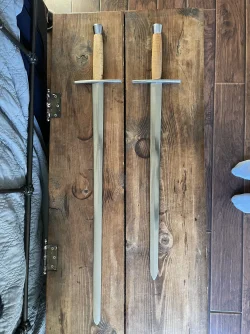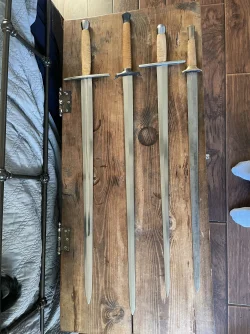Ok here goes. is this discussion of cut vs. thrust from Jian vs. Dao allegorical to European sword evolution or styles? Say side sword vs small sword vs rapier for example. One led to another over a period of time in Europe is my limited understanding, but what caused the change? Dueling? battlefield combat? Styles of dress? I guess what I’m asking is, were there similar reasons for people to change the type of sword they carried? In looking at the various types of swords used on the battlefield, it seems to me that the saber was the last type commonly used. How come? Cut vs. thrust? I’m rambling here because I clearly don’t know what I’m talking about. Apologies.
Good questions, and honestly I do not have a well researched answer for you. However, I believe it is safe to say that weapons and armor have evolved hand-in-hand, the one to counter the other. I believe this is well documented in Europe, and I have to believe something similar happened in Asia. Weapons were developed, and armor was then developed to protect against those weapons. And the weapons were altered to defeat that armor, and the armor was altered in turn. I suspect this was an on-going process and happened repeatedly over history. Generally, as armor became more effective, cuts became less effective and thrusts more likely to be effective at least in comparison to cuts. So swords gradually evolved to focus more on thrusting meaning they had a narrower profile and a thicker, more robust point. Somewhere along the way swords took on a shape that attempted to effectively be both a cut-and-thrust weapon. These had reasonably wide blades (a wider blade is better for cutting) with a more sharply tapered point. Eventually they became overall more pointed as tough plate armor (in Europe) became more common.
I believe that in China, there was a difference between a weapon that would be carried on the battlefield, vs. one carried by a civilian for self defense. The battlefield weapon would be more robust to withstand the rigor of the battlefield and to be effective against armor, while the civilian weapon would be less likely to need to be so robust given that civilians would be unlikely to be wearing armor, and a civilian self defense encounter would probably be brief and would not need to engage repeatedly against many enemies, some of them using heavy military pole-arms and such. I suspect technique and training methods would also reflect these differences in the weapons, there likely being different methodologies employed by the military vs. those employed by civilians.
In the modern age in the practice of traditional Chinese martial arts, it is unclear to me how well the weapon designs match history, and how well the technique and practice methods match the weapons with which they were historically developed. It is further unclear to me if it matters at all, on any functional level, so long as the practitioner is using a weapon that fits them well (enough).
But at any rate, I suspect that at least on some level the modern makers in China (at least those making them in quantity) are using designs that are easy to reproduce, with some amount of suspected historical accuracy, but may be driven more by profit and sales as long as the design meets at least a superficial historical satisfaction, but without heavy interest in strict historical accuracy. I myself am less interested in my weapons satisfying any historical accuracy, and more that they are simply robust and solidly constructed and functional.
I believe that for a time these weapons were being over-built, resulting in heavy, cumbersome weapons. I think the makers at the time (like the 1960s-1990s) did not understand how tough a properly made, lighter and thinner blade could be. As their understanding improved, the more recently made weapons reflect that understanding. They tend to be lighter and much more maneuverable, at least those made in the European designs. But the opposite end of that of course is the super-light junk made for Modern Wushu. This stuff is utter garbage and is nothing more than a stage-prop in the shape of a sword. I think there is still a lot of over-heavy stuff coming out of China, but some makers are getting better at making quality, well weighted and well balanced swords.
Regarding sabers, a curved blade is better for cutting, it is often less effective at the thrust. However, it can still thrust effectively if the tip lines up in a straight line with the grip. I believe sabers came into high use in the cavalry because on a galloping horse a cut was preferred, taking advantage of the momentum. A thrust into an enemy could result in a lost sword as it would be difficult to withdraw the weapon when galloping at speed.



